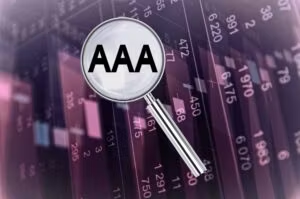America Loses Its Last Sterling “AAA” Credit Rating Due to Rising Debt
Posted on — Leave a commentAmerica’s credit isn’t as good as it used to be. In a surprise announcement, Moody’s Ratings downgraded the U.S. government’s credit in mid-May. Moody’s Ratings was the last of the three major ratings agency that had given America access to the exclusive Triple-A club. No more.
Moody’s downgraded its credit rating of the United States to “Aa1” from “AAA.” The firm pointed to rising debt and interest “that are significantly higher than similarly rated sovereigns.”
“Successive U.S. administrations and Congress have failed to agree on measures to reverse the trend of large annual fiscal deficits and growing interest costs,” Moody’s said. “We do not believe that material multi-year reductions in mandatory spending and deficits will result from current fiscal proposals under consideration.”
What Is a Credit Rating?
When you apply for a new credit card, the financial institution looks at your credit score. For a nation, a credit rating is an assessment of the government’s ability to repay its debt, like the Treasury bonds and notes that it sells.
The highest rating is AAA, and then ratings move lower indicating default risk from AA to BBB to C and lower. For governments, a high credit rating signals strong fiscal health and a high likelihood of repaying debts on time, while a lower rating suggests increased risk for lenders and investors.
Why Does the U.S. Credit Rating Matter?
The U.S. credit rating is important because it directly impacts the cost of borrowing for the government. When our nation carried an AAA rating, it could borrow money at the lowest possible interest rates, as investors saw our debt as virtually risk-free.
A downgrade signals to investors that lending to the U.S. is slightly riskier, prompting them to demand higher interest rates to compensate for that risk.
Bottom line? A lower credit rating means higher borrowing costs when the U.S. government auctions off Treasury bond and notes to pay our national debt. This can also lead to higher borrowing costs for consumers since U.S. Treasury yields serve as a benchmark for many other interest rates throughout the economy.
What Does a Downgraded Credit Rating Mean for the U.S. Economy and You
Looking ahead, this news could have real-life consequences for our government and everyday Americans including:
Higher Borrowing Costs: The U.S. government may have to pay more to borrow money, which can increase the federal deficit over time
Rising Interest Rates: As Treasury yields rise, so do rates on mortgages, auto loans, and corporate debt, making borrowing more expensive for households and businesses
Market Volatility: Downgrades can unsettle financial markets, causing volatility in stocks, bonds, and currencies as investors reassess risk
The 2011 U.S. Credit Downgrade and Its Impact on Gold
Looking back, the first-ever downgrade of the US credit rating occurred in August 2011, when Standard & Poor’s lowered the U.S. from AAA to AA+
This downgrade unfolded amid intense political standoffs in Congress over the U.S. debt ceiling and sent shockwaves through the stock market and gold soared to record highs. Investors turned to the safety of gold as the U.S. government’s credit-worthiness was questioned, which led to bigger questions about the stability of the U.S. financial system.
What Could the Latest Downgrade Mean for Gold Now?
In August 2023, Fitch lowered its US credit rating from AAA to AA+. And, now Moody’s has also lowered theirs. The news underscores the stability and security of gold in a world racked with government debt.
For gold investors, this helps underscore that gold is in a structural bull market. Analysts at JP Morgan issued a new research note in mid-May outlining a scenario that could take gold 80% higher to $6,000 by 2029. They said this could occur if just 0.5% of U.S. assets held by foreign investors was reallocated gold.
Do You Own Enough?
Never before in history has there been such a strong case for gold ownership. With rising government debt, political brinksmanship, and concerns about fiscal sustainability, gold acts as a safe haven, a store of value and a vehicle to grow your wealth. It’s easy to increase your wealth protection with an increased allocation to gold. Why not do it today?
Want to read more? Subscribe to the Blanchard Newsletter and get our tales from the vault, our favorite stories from around the world and the latest tangible assets news delivered to your inbox weekly.








